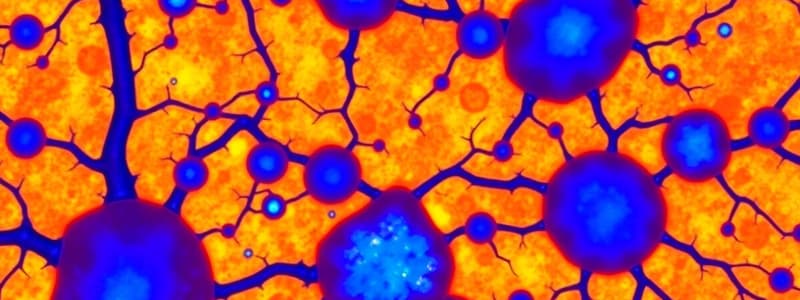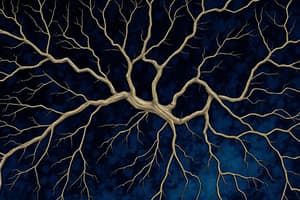Podcast
Questions and Answers
Which method was devised by Camillo Golgi to visualize nerve cells?
Which method was devised by Camillo Golgi to visualize nerve cells?
- Gold chloride staining
- Hematoxylin staining
- Silver nitrate staining (correct)
- Nissl staining
How did Santiago Ramón y Cajal's findings contradict the reticular theory?
How did Santiago Ramón y Cajal's findings contradict the reticular theory?
- By identifying multiple types of neurotransmitters
- By showing neurons function independently (correct)
- By introducing the concept of neuroplasticity
- By illustrating neuronal degeneration
What recognition did Cajal receive for his contributions to neuroscience?
What recognition did Cajal receive for his contributions to neuroscience?
- The Fields Medal
- The Crafoord Prize
- The Nobel Prize (correct)
- The Wolf Prize
For how many hours a day did Cajal typically study nerve cells?
For how many hours a day did Cajal typically study nerve cells?
What fundamental principle of neuroscience did Cajal's observations support?
What fundamental principle of neuroscience did Cajal's observations support?
What material did Cajal predominantly use for his detailed drawings?
What material did Cajal predominantly use for his detailed drawings?
Which element in Cajal's work was instrumental in challenging the reticular theory?
Which element in Cajal's work was instrumental in challenging the reticular theory?
What major contribution to neuroscience did Golgi and Cajal make together?
What major contribution to neuroscience did Golgi and Cajal make together?
Which statement reflects Cajal's philosophical stance on the brain?
Which statement reflects Cajal's philosophical stance on the brain?
What scientific tool or technique did Cajal refine to facilitate his observations?
What scientific tool or technique did Cajal refine to facilitate his observations?
Flashcards
Golgi's Method
Golgi's Method
A tissue-staining technique using silver nitrate to visualize nerve cells.
Cajal's Method
Cajal's Method
Enhanced Golgi's technique, allowing complete visibility of nerve cells.
Neuron Doctrine
Neuron Doctrine
The principle that the nervous system is made of independent neurons.
Reticular Theory
Reticular Theory
Signup and view all the flashcards
Nobel Prize 1906
Nobel Prize 1906
Signup and view all the flashcards
Cajal's Illustrations
Cajal's Illustrations
Signup and view all the flashcards
Synapses
Synapses
Signup and view all the flashcards
Cajal's Observation Time
Cajal's Observation Time
Signup and view all the flashcards
Impact of Cajal's Work
Impact of Cajal's Work
Signup and view all the flashcards
Cajal's Quote
Cajal's Quote
Signup and view all the flashcards
Study Notes
Camillo Golgi and Santiago Ramón y Cajal
-
Golgi developed a tissue staining technique, crucial for visualizing nerve cells.
-
In 1873, Golgi used silver nitrate to stain nerve cells, improving visibility under a microscope.
-
Golgi supported the reticular theory, believing nerve fibers formed a continuous network.
-
Golgi and Cajal shared the Nobel Prize in 1906.
-
Golgi was a staunch supporter of the reticular theory even after evidence supporting the neuron doctrine emerged.
Cajal's Work
-
Cajal modified Golgi's staining method to better visualize nerve cells in various animals.
-
He meticulously documented the brain and nervous systems from diverse species.
-
Cajal’s work refuted the reticular theory, proposing the neuron doctrine—nerve cells are discrete and connected through synapses.
-
Cajal's detailed drawings were revolutionary, portraying the intricate network of neurons.
-
Cajal employed pen and ink to reproduce the structure of the nervous system and brain with almost photographic precision.
Neuron Doctrine
-
This theory postulates that nerve cells are discrete units in the nervous system.
-
The Neuron doctrine emphasized specific connections between nerve cells.
-
These connections happen across small gaps (synapses).
-
Synapses are gaps across which electrical and chemical signals travel in the brain.
Significance of Golgi and Cajal's contributions
-
Their work fundamentally shifted the model for understanding the structure and function of the nervous system: shifting from a reticular to neuron doctrine model.
-
The neuron doctrine, supported and championed by Cajal, paved the way for modern neuroscience.
-
Cajal's contributions included extensive and detailed illustrations that helped transmit his research.
Studying That Suits You
Use AI to generate personalized quizzes and flashcards to suit your learning preferences.




